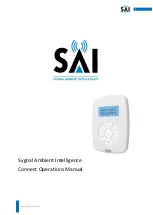
User and Installation Manual
ALPHA 16 - 248 GBR
Conventional Modular Fire Alarm
Control Panel
Document :
MUALPHA16248GB
Index
: A
Date
: 26/03/07
Page
: 13/49
FAULT LED
When ON, this indicates there is a fault in the panel and the corresponding output is on (apart from specific
deactivation).
The details on fault occurring are indicated by other LED on the panel and/or alphanumeric display.
LOCK (DEACTIVATION) LED
When ON, this indicates that there is a general state of deactivation in the panel (zones/sounders or another part
deactivated).
The details on deactivation may be displayed by other LED or may be visualized on the display by using the keyboard
when in access level 2.
ALARM LED.
When permanently ON, this indicates that there is a state of alarm in the panel and that the corresponding main
output is on (apart from specific deactivation).
If it flashes on for a long time and off briefly, it indicates that the alarm delay stage is in progress.
When the general alarm LED is ON, it is accompanied by one or more of the corresponding zone LED for the origins
of the alarm. The display also visualizes lines in the state of alarm.
= FAULTS LED; indicate specific panel faults as required by standards UNI EN 54-2 and 54-4, which are:
Power supply
fault LED.
When permanently ON, it indicates that the panel power supply or supplementary power supply group (if applicable) is
irregular and that there is one of the following abnormal states:
- mains power lacking for more than 20 minutes
- output voltage of power supply is outside adjustment limits (<22.5V or >29.5V)
- the battery is disconnected or inefficient
- there is a fault on the battery recharge circuit
The flashing LED indicates that the power supply is regular but there has previously been an abnormal state
(memorized signal).
Earth
fault LED.
When permanently ON, it indicates that there is a state of low isolation between one of the electric parts on the
system and earth. If it flashes, it indicates that the current state is regular but there has previously been an abnormal
state (memorized signal).
Sounders
fault LED.
When permanently ON, it indicates that there is a fault on a balanced line which controls the alarm actuators
(sounders line balance not ok). If it flashes, it indicates that the current state of the line is regular but there has
previously been a state of fault (memorized signal).
System
fault LED.
This can indicate different system faults, namely:
a) The panel microprocessor is temporarily or permanently out of control. This type of fault may be caused by strong
interference of an electrostatic nature, by a sudden drop in the power supply voltage or by a physical fault in the
panel card. In the latter case the signal can be stopped but not reset.
This type of fault, unless there is a serious physical card fault, is indicated on the display with one of the following
messages:
CPU/MEMORY FAULT, WRONG CPU RESET FAULT.
b) One or more of the input or output concentrator modules are temporarily or permanently out of service. Also in this
case the fault may be caused by strong interference, by a sudden drop in the power supply voltage or by a physical
fault in the concentrator or communication line (short circuit/cut).
This type of fault can also be indicated on the display as INTERFAC.COMUNIC. FAULT and as a fault relative to the
zones linked to the concentrators out of service.
c) The content of the panel memory or firmware of an extension module has been altered.
In this case the display can visualise one of the following messages: WRONG CONFIGUR., MEMORY DATA ERR.,
CPU / MEM. FAULT.
2














































